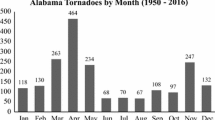Abstract
Tornadoes are the most violent atmospheric hazards in the world in terms of human fatalities, injuries, and economic damages. The USA, especially the south and central states, faces numerous tornado disasters. However, there is a lack of good models for reliable tornado risk analysis. This research develops two spatial risk analysis models, base model and location quotient model, for the forty-eight continental US states, using a database for all tornadoes reported during 1950–2012. The models are based on state-level expected losses, standard deviations, and their corresponding state-level percentages, ranges, and ranks of tornado-induced human injuries and fatalities. The models are validated using Pearson’s and Spearman’s correlations and scatter plots for samples and population of the tornado database. The results show that the models perform well in terms of yielding consistent expected tornado risks and related measures at the state level. The models serve as good alternatives to existing models for spatial tornado risks and ranks in the USA.







Similar content being viewed by others
References
Alan WB, Walker SA (2010) Nontornadic convective wind fatalities in the United States. Nat Hazards 54:355–366
Alan WB, Walker SA (2011) The relationship between tornadic and nontornadic convective wind fatalities and warnings. Weather Clim Soc 3:31–47
Blaikie P, Cannon T, Davis I, Winser B (1994) At risk: natural hazards, people’s vulnerability, and disasters. Routledge, London
Borden KA, Cutter SL (2008) Spatial patterns of natural hazards mortality in the United States. Int J Health Geogr 7(64):1–13
Boruff BJ, Easoz JA, Jones SD, Landry HR, Mitchem JD, Cutter SL (2003) Tornado hazards in the United States. Clim Res 24(2):103–117
Brooks HE, Doswell CA III (2001) Normalized damage from major tornadoes in the United States: 1890–1999. Weather Forecast 16(1):168–176
Bryan TS, Tomas EC, Andrew CW, Corey MM, Andrew RD, Richard LT (2013) Measured severe convective wind climatology and associated convective modes of thunderstorms in the contiguous United States, 2003–09. Weather Forecast 28(1):229–236
Cheng V, Arhonditsis GB, Sills DM, Auld H, Shephard MW, Gough WA, Klaassen J (2013) Probability of tornado occurrence across Canada. J Clim 26(23):9415–9428
Cutter SL, Boruff BJ, Shirley WL (2003) Social vulnerability to environmental hazards. Soc Sci Q 84(2):242–261
Dixon RW, Moore TW (2012) Tornado vulnerability in Texas. Weather Clim Soc 4(1):59–68
Donner WR (2007) The political ecology of disaster: an analysis of factors influencing US tornado fatalities and injuries, 1998–2000. Demography 44(3):669–685
Doswell CA III, Burgess DW (1988) On some issues of United States tornado climatology. Mon Weather Rev 116:495–501
Eppelbaum LV (2013) Non-stochastic long-term prediction model for US tornado level. Nat Hazards 69:2269–2278
Gladwin H, Peacock WG (2000) Warning and evacuation: a night for hard houses. In: Peacock WG, Morrow BH, Gladwin H (eds) Hurricane Andrew: ethnicity, gender, and the sociology of disaster. Laboratory for Social and Behavioral Research, Florida International University, Miami, pp 52–72
Jonkman SN (2005) Global perspectives on loss of human life caused by floods. Nat Hazards 34(2):151–175
Lindell MK (1994) Perceived characteristics of environmental hazards. Int J Mass Emerg 12:303–326
Lindell MK (2013) Disaster studies. Curr Sociol 61(5–6):797–825
National Oceanic and Atmospheric Administration (2014) Severe weather. http://www.weather.gov/cae/tornado.html. Accessed Oct 2014
National Weather Service (2014) Natural hazard statistics. http://www.nws.noaa.gov/om/hazstats.shtml. Accessed Oct 2014
Newark MJ (1984) Canadian tornadoes, 1950–1979. Atmos Ocean 22(3):343–353
Newark MJ (1988) The tornado hazard in Canada. In: Mohammed IES, Tad SM (eds) Proceedings of the International Symposium, Rimouski, Quebec, Canada, August 3–9, 1986, pp 743–748
Oliver-Smith A, Cutter SL, Warner K, Corendea C, Yuzva K (2012) Addressing loss and damage in the context of social vulnerability and resilience. Policy Brief No. 7, United Nations University, Institute for Environment and Human Security, Bonn, Germany
Pielke RA Jr, Pielke RA Sr (1997) Hurricanes: their nature and impact on society. Wiley, Hoboken
Rasmussen EN, Straka JM, Davies-Jones R, Doswell CA III, Carr FH, Eilts MD, MacGorman DR (1994) Verification of the origins of rotation in tornadoes experiment: VORTEX. Bullet Am Meteorol Soc 75(6):995–1006
Richard LT, Bryan TS, Andrew RD, Marsh PT (2013) Spatial distributions of tornadic near-storm environments by convective mode. Electron J Sev Storms Meteorol 8(5):1–22
Simmons KM, Sutter D (2008) Tornado warnings, lead times, and tornado casualties: an empirical investigation. Weather Forecast 23(2):246–258
Simmons KM, Sutter D (2011) Economic and societal impacts of tornadoes. University of Chicago Press, Chicago
Simmons KM, Sutter D, Pielke R (2013) Normalized tornado damage in the United States: 1950-2011. Environ Hazards 12(2):132–147
SPC (Storm Prediction Center) (2014) Severe weather database files (1950–2012). http://www.spc.noaa.gov/wcm/. Accessed Oct 2014
Stanley AC (2009) Tornado losses in the United States. Nat Hazards Rev 10(4):145–150
Stanley AC, David C (1998) Record-high losses for weather disasters in the United States during the 1990s: how excessive and why? Nat Hazards 18:287–300
Stanley AC, Joyce MC (1992) Storm catastrophes in the United States. Nat Hazards 6:93–107
Stanley AC, Semonin RG (1966) A great tornado disaster in retrospect. Weatherwise 19(2):56–65
Storm Prediction Center (2013) Tornadoes (1950–2013). http://www.spc.noaa.gov/gis/svrgis/. Accessed 20 Oct 2014
Tran P, Shaw R, Chantry G, Norton J (2009) GIS and local knowledge in disaster management: a case study of flood risk mapping in Viet Nam. Disasters 33(1):152–169
Verbout SM, Brooks HE, Leslie LM, Schultz DM (2006) Evolution of the US tornado database: 1954–2003. Weather Forecast 21(1):86–93
US Census Bureau (2013) TIGER/line shapefiles and TIGER/line files. https://www.census.gov/geo/maps-data/data/tiger-line.html. Accessed 20 Oct 2014
Wakimoto RM, Wilson JW (1989) Non-supercell tornadoes. Mon Weather Rev 117(6):1113–1140
Walker SA (2007) Spatial and temporal analysis of tornado fatalities in the United States: 1880–2005. Weather Forecast 22(6):1214–1228
White DH (1994) Climate variability, ecologically sustainable development and risk management. Agric Syst Inf Technol 6(2):7–8
Zhijun T, Jiquan J, Xingpeng L (2009) GIS-based risk assessment of grassland fire disaster in Western Jilin Province, China. Stoch Environ Res Risk Assess 23(4):463–471
Author information
Authors and Affiliations
Corresponding author
Rights and permissions
About this article
Cite this article
Shen, G., Hwang, S.N. A spatial risk analysis of tornado-induced human injuries and fatalities in the USA. Nat Hazards 77, 1223–1242 (2015). https://doi.org/10.1007/s11069-015-1654-5
Received:
Accepted:
Published:
Issue Date:
DOI: https://doi.org/10.1007/s11069-015-1654-5




